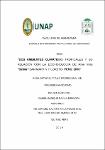| dc.contributor.advisor | Ávila Fucos, Manuel Calixto | |
| dc.contributor.advisor | Pinedo Jiménez, Julio | |
| dc.contributor.author | Dávila Espinoza, Daniel Enrique | |
| dc.date.accessioned | 2021-01-25T13:21:23Z | |
| dc.date.available | 2021-01-25T13:21:23Z | |
| dc.date.issued | 2020 | |
| dc.identifier.uri | http://repositorio.unapiquitos.edu.pe/handle/20.500.12737/7107 | |
| dc.description.abstract | El presente trabajo de investigación “Dos ambientes climáticas tropicales y
su relación con la eco-fisiología de Aloe vera “sábila” San Martin y Loreto-
Perú, 2018.”, se realizó bajo las condiciones de climáticas de la selva
amazónica, las plantas se evaluaron cuando fueron sembradas y
desarrolladas en dos regiones ecológicos, con el objetivo de evaluar si el
ambiente climático influye en el comportamiento del desarrollo vegetativo
de la sábila, el nivel de investigación es explicativo, con dos tratamientos y
20 replicaciones, las unidades de estudio son las plantas de sábila que se
criaron en bolsas negras conteniendo una mezcla uniforme de tierra suelta,
materia orgánica y estiércol de aves de corral. La prueba de la distribución
de “t” de Student muestran valores numéricos superiores para la región
Loreto, no mostrando diferencia estadística significancia para altura de
planta, diámetro de planta, cantidad total de hojas por planta y longitud de
hoja basal, presentando diferencia estadística significativa para hojas
basales en ancho, diámetro y peso; se concluye que los procesos
fisiológicos de la sábila muestran periodos más cortos en la región Loreto
con la aparición del eje floral antes del año y medio de edad y en San
Martín después del año y medio, las condiciones edafoclimáticas
determinan el desarrollo vegetativo, desde el crecimiento, cantidad total de
hojas, brotamiento de hijuelos, incluso cantidad de hojas basales hasta la
aparición de los ejes florales. | es_PE |
| dc.description.abstract | The present research work "Two tropical climatic environments and their
relationship with the eco-physiology of Aloe vera" sábila "San Martin and
Loreto- Peru, 2018.", was carried out under the climatic conditions of the
Amazon rainforest, the plants were evaluated when they were planted and
developed in two ecological regions, with the aim of evaluating whether the
climatic environment influences the behavior of the vegetative development
of aloe vera, the research level is explanatory, with two treatments and 20
replications, the study units are aloe plants that were raised in black bags
containing a uniform mixture of loose soil, organic matter and poultry
manure. The Student's “t” distribution test shows higher numerical values
for the Loreto region, showing no statistical difference of significance for
plant height, plant diameter, total number of leaves per plant and basal leaf
length, presenting a statistically significant difference for basal leaves in
width, diameter and weight; It is concluded that the physiological processes
of aloe vera show shorter periods in the Loreto region with the appearance
of the floral axis before the year and a half of age and in San Martín after
the year and a half, the edaphoclimatic conditions determine the vegetative
development, from the growth, total number of leaves, sprouting of suckers,
including number of basal leaves until the appearance of the flower axes. | en_US |
| dc.format | application/pdf | es_PE |
| dc.language.iso | spa | es_PE |
| dc.publisher | Universidad Nacional de la Amazonía Peruana | es_PE |
| dc.rights | info:eu-repo/semantics/openAccess | es_PE |
| dc.rights | Attribution-NonCommercial 3.0 United States | * |
| dc.rights.uri | http://creativecommons.org/licenses/by-nc/3.0/us/ | * |
| dc.source | Universidad Nacional de la Amazonía Peruana | es_PE |
| dc.source | Repositorio institucional - UNAP | es_PE |
| dc.subject | Sávila | es_PE |
| dc.subject | Aloe vera | es_PE |
| dc.subject | Clima tropical | es_PE |
| dc.subject | Ecología vegetal | es_PE |
| dc.subject | Fisiología vegetal | es_PE |
| dc.title | Dos ambientes climáticos tropicales y su relación con la ecofisiología de Aloe vera “sábila” San Martin y Loreto- Perú. 2018 | es_PE |
| dc.type | info:eu-repo/semantics/bachelorThesis | es_PE |
| thesis.degree.discipline | Agronomía | es_PE |
| thesis.degree.grantor | Universidad Nacional de la Amazonía Peruana. Facultad de Agronomía | es_PE |
| thesis.degree.name | Ingeniero(a) Agrónomo | es_PE |
| thesis.degree.program | Presencial | es_PE |
| dc.subject.ocde | http://purl.org/pe-repo/ocde/ford#4.01.06 | es_PE |
| renati.author.dni | 46740972 | |
| renati.advisor.dni | 05327621 | |
| renati.advisor.dni | 05248692 | |
| renati.type | http://purl.org/pe-repo/renati/type#tesis | es_PE |
| renati.discipline | 811036 | es_PE |
| renati.level | http://purl.org/pe-repo/renati/level#tituloProfesional | es_PE |


